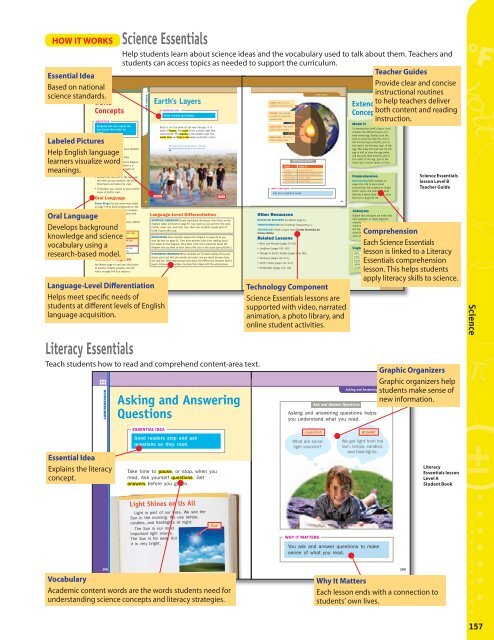Science Essentials - McGraw-Hill Books
Science Essentials - McGraw-Hill Books
Science Essentials - McGraw-Hill Books
You also want an ePaper? Increase the reach of your titles
YUMPU automatically turns print PDFs into web optimized ePapers that Google loves.
HOW IT WORKSEssential IdeaBased on nationalscience standards.BuildConceptsOBJECTIVEStudents will learn about thefour layers that make upEarth.Labeled Pictures IntroduceHelp English languagelearners visualize wordmeanings. Read aloud the title and have studentsrepeat after you. Read aloud the Essential Idea. Invite students to look at the diagramon page 93 and engage them in adiscussion about the four layers ofEarth. Explain that the crust is the layer yousee when you go outdoors; the otherthree layers are below the crust. If possible, use a globe to give anothervisual of Earth’s crust.Oral LanguageSeven Steps Use the seven-step modelon page T39 to build background on theacademic content words. Have studentspractice their oral language skills withpartners or groups in Step 6.Vocabulary Introduce vocabulary relatedto the concept.Oral LanguageDevelops backgroundAcademicContent Wordsknowledge and scienceOn-the-SpotWordsvocabulary using aAcademicProcess Wordsresearch-based model.92EARTH SCIENCELanguage-Level DifferentiationCOMPREHENSIONlayer, crust, mantle, outercore, inner coreland, ocean, rock, soil,liquid, metalnot, same, all the waythrough, make upMonitor ProgressUse Master page 44 and class discussionto monitor student progress. Use therubric on page T46 as a resource.EARTH SCIENCE92oceanHelps meet specific needs ofstudents at different levels of Englishlanguage acquisition.<strong>Science</strong> <strong>Essentials</strong>Help students learn about science ideas and the vocabulary used to talk about them. Teachers andstudents can access topics as needed to support the curriculum.ESSENTIAL IDEAEarth is made up of layers.layers. crustmantleouter coreinner coreThe crust is the land you walk on. The landunder the oceans is part of the crust, too.Language-Level DifferentiationSTARTING/EMERGING Slowly read aloud the lesson, then focus on thediagram labels and text on page 93. Say: layers as you point to the crust,mantle, outer core, and inner core, then have students repeat each ofEarth’s layers after you.DEVELOPING Have students explore the diagram on page 93 as youread the text on page 92. Then have partners take turns reading aloudthe labels on the diagram. Have them write short sentences about thediagram and say them to each other (The crust is the outer layer of Earth.)EXPANDING/BRIDGING When students are finished reading the lessonaloud, point out that the mantle and outer core are liquid because theyare very hot. Have small groups talk about the differences between Earth’slayers. Encourage volunteers to share their ideas with the whole group.Literacy <strong>Essentials</strong>Teach students how to read and comprehend content-area text.Asking and AnsweringQuestionslandcrust The crust ismade of rocks and soil.mantle The mantleis made of solid andmelted rock.outer core The outercore is liquid metal.inner core The innercore is solid metal.WHY IT MATTERSYou live on Earth’s crust.Other ResourcesBLACKLINE MASTERS Use Master page 44.TRANSPARENCIES Use Overhead Transparency 4.TECHNOLOGY Earth’s Layers from Content <strong>Essentials</strong> for<strong>Science</strong> Online.Related Lessons Rocks and Minerals (pages 94–95) Landforms (pages 102–105) Changes to Earth’s Surface (pages 106–109) Volcanoes (pages 110–111)layercrustmantleouter coreinner core Earth’s Plates (pages 112–113) Earthquakes (pages 114–115)What Makes Up Earthmade ofrocks and soilsolid and melted rockliquid metalsolid metalTechnology Component<strong>Science</strong> <strong>Essentials</strong> lessons aresupported with video, narratedanimation, a photo library, andonline student activities.Ask and Answer QuestionsAsking and Answering QuestionsAsking and answering questions helpsyou understand what you read.93Teacher GuidesProvide clear and conciseinstructional routinesExtend to help teachers deliverConcepts both content and readinginstruction.Model ItTo demonstrate Earth’s layers, showstudents the different layers of ahard-boiled egg. Gently crack theshell to point out that the crust isthe thinnest layer of Earth, just asthe shell is the thinnest layer of theegg. Peel away the shell and cut theegg in half to show the egg whiteand the yolk. Note that the yolk isthe center of the egg, just as theinner core is at the center of Earth.ComprehensionSummarizing Refer students topages 254–255 to learn aboutsummarizing. Ask students to rereadEarth’s Layers and summarize whatthey know about Earth’s layers usingthe text on pages 92–93.AntonymsExplain that antonyms are words thathave opposite, or nearly opposite,meanings. For example, outside andinside are antonyms. Have studentstell the antonyms for the followingwords from the lesson: same (different),outer (inner), under (over; above).ComprehensionEach <strong>Science</strong> <strong>Essentials</strong>Cognatesrock lesson la roca is linked to a Literacysolid el sólidoliquid el líquido<strong>Essentials</strong> comprehensionmetal el metalcenter el centrolesson. This helps studentsEarth’s Layers93<strong>Science</strong> <strong>Essentials</strong>lesson Level BTeacher Guideapply literacy skills to science.Graphic OrganizersGraphic organizers helpstudents make sense ofnew information.<strong>Science</strong>Essential IdeaExplains the literacyconcept.ESSENTIAL IDEAGood readers stop and askquestions as they read.Take time to pause, or stop, when youread. Ask yourself questions. Getanswers before you go on.questionWhat are somelight sources?answerWe get light from theSun, lamps, candles,and flashlights.Literacy<strong>Essentials</strong> lessonLevel AStudent BookLight Shines on Us AllLight is part of our lives. We see theSun in the morning. We use lamps,candles, and flashlights at night.The Sun is our mostimportant light source.The Sun is far away, butit is very bright.SunWHY IT MATTERSYou ask and answer questions to makesense of what you read.168VocabularyAcademic content words are the words students need forunderstanding science concepts and literacy strategies.Why It MattersEach lesson ends with a connection tostudents’ own lives.169157
















